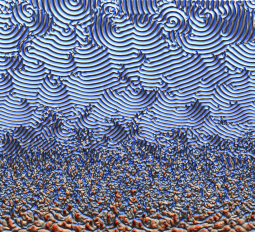Bridging scales in a multiscale pattern-forming system
Laeschkir Würthner*, Fridtjof Brauns*, Grzegorz Pawlik, Jacob Halatek, Jacob Kerssemakers, Cees Dekker, Erwin Frey

We address the intricate dynamics of self-organized pattern-forming systems that span multiple spatial and temporal scales, and demonstrate an approach that enables us to reconstruct and forecast the dynamics at small scales from a reduced dynamics at large length and time scales. Our work provides a new route to deal with complex multiscale dynamics that emerge in a broad range of physical systems.
Spatiotemporal patterns are vital for the organization of many biological processes such as cell division, collective cell migration, and morphogenesis. Although commonly assumed in theoretical approaches on pattern-forming systems, patterns generally do not emerge from homogeneity, but rather transition from one pattern to another over time and across different spatial regions – a key scientific challenge, as Turing pointed out in his seminal paper on pattern formation. Coarse-graining methods allow the dynamics of such multiscale systems to be reduced to the essential degrees of freedom at large scales. However, a drawback of traditional coarse-graining approaches is that information about the patterns at small scales, that are integrated out, are lost and cannot be reconstructed from the dynamics at large scales.
We present an approach that overcomes this shortcoming for mass-conserving reaction-diffusion systems. We show that information about patterns at small scales can be reconstructed from coarse-grained total densities. These densities are governed by a reduced dynamics at large scales which enables long-term forecasting. We illustrate the potential of our approach by studying the Min Protein system, a paradigmatic model for biological pattern formation, in which a fixed spatial heterogeneity is applied to a control parameter. By performing large-scale numerical simulations, we show that this heterogeneity induces complex multiscale patterns in the Min dynamics. We confirm this theoretical prediction experimentally by reconstituting the Min protein system in an in vitro flow cell setup. Building up on a recently developed theoretical framework for mass-conserving reaction-diffusion systems, we then show that the (globally conserved) total protein densities are the relevant degrees of freedom in the system. Importantly, we show that the diffusive redistribution of the total densities at large scales enables reconstruction and even prediction of patterns at small scales.
The reconstruction of information at small scales from a reduced dynamics at large scales provides a new way to deal with complex multiscale systems. Since conservation laws are ubiquitous in physics, we believe that our approach has the potential to shed light on underlying physical principles of multiscale pattern formation.

